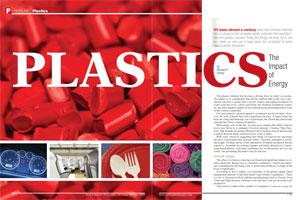

It’s been almost a century since new chemical methods led to a boom in the innovative plastic polymers that revolutionized the plastics industry. Today, the things we drive, fly in, eat our meals on, and use to keep warm are composed of some type of plastic derivative.
The plastics industry has become a driving force in today’s economy. The impact is so considerable that just the smallest shift in the cost of production can have a global affect on jobs, wages, and capital circulation on every economic level. Lately, petroleum, the chemical foundation of plastic, has had a negative impact on the manufacturing and transportation costs of this critical commodity.
For years, plastic's greatest appeal to consumers was its low price. However, the cost of plastic has seen a significant increase. A major cause has been the rising and unsteady cost of petroleum, the chemically-altered raw material that forms commercial plastics.
With energy costs on the rise, it comes as no surprise that utility costs are now a key driver in a company’s location strategy. Creating “Best Practices” that includes an energy efficient look in location choices has become a critical decision many executives have come to make.
With some observers suggesting that future oil reserves are uncertain, the price of petroleum may increase further. Therefore, alternatives are being sought. Oil shale and tar oil are alternatives for plastic production but are expensive. Scientists are seeking cheaper and better alternatives to petroleum-based plastics, and many candidates are in laboratories all over the world. One promising alternative may be fructose.
Outlook: Global
The effect of oil prices is having a profound and significant impact on location decisions. Being close to customers, consumers’ vendors are important considerations but being close to petroleum producers is rising in the level of significance.
According to Roy Lenders, vice president of the global supply chain management practice of the Paris-based Cape Gemini Consultancy, “There is a lot of discussion about pulling manufacturing back to Europe from China and India because container costs and fuel costs are favoring local production.
“That trend is evident with a number of companies who are now setting up factories in Eastern Europe to move at least part of their manufacturing back. Wal-Mart buys most of its plastic products from China. Those products are made with oil, and manufacturers are experiencing huge increases in material costs. They also have increased transportation costs. Those companies are having huge difficulties, and it will be interesting to see where the new balance will be found.”
“Eighty percent of the raw material costs are related to oil, so production might even go to the Middle East to be close to oil production,” Lenders continued. “All of the logistics service providers I know of are operating in Dubai. It's a two-part strategy to reach companies in the Middle East and to mitigate the rising cost of oil. You can operate an intercontinental hub for both Asia and Europe. Dubai is a hot area at the moment.”
The process of selecting the right site, in the right community, with the right incentives is ever evolving. The structured process, stakeholder ownership, and the right third-party site selector are vital to success in choosing the right location.
Look to the future as well as to the past in considering a location. Long-term community plans to recruit priority business that may conflict with your operations can affect you, and when searching overseas, understanding the financial and political stability are of critical importance.
Start with the Stakeholder Team at the most appropriate level. Obtain buy-in from the C Suite to start on the right foot, but make sure the team has “worker bees.” Stakeholders include real estate, engineering, tax, finance, legal, affected business unit, government affairs, logistics, human capital – and others that may provide valuable input.
Select the right third-party site selector to help “herd the cats” and bring the highest level of objectivity to the process.
Know What You Are Buying
Understand what you should expect from a site selection consultant. Know what they can and should produce and what they are not. Their role is to bring success, best practices learned from other companies, objectivity and facilitation skills. But how do you evaluate their potential to be the best fit for you?
To start with, and just like any service provider, not all site selectors are the same. Experience, style, approach and direct corporate experience are key ingredients. The right fit in your culture is paramount. How do they interact with your Stakeholders Team and do they understand the internal corporate values? Relationships are vital. Success in business can be 80 percent relationship driven. Performance and outcome do matter, but the ability to lead, the trust factor, and confidence in the site selector are critical requirements. If you have successfully worked with the consultant before, then it is a good bet future success will be achieved.
The Emotional Quotient is often more important than the Intellectual Quotient (IQ). Leading a group to success relies a great deal on interpersonal communications.
Factors for Success
Even with a business climate that is ever changing, or in an up/down economy, your site selection strategy must remain focused on the long term. Structuring your approach to accomplish short-term gains will not lead you to achieve the kind of partnership needed to sustain strong and healthy development.
A company looking to relocate should first determine their particular “Factors for Success.” Then, when performing due diligence and before investing significant capital, the process should always include a list of potential site locations. The process of the intense search begins to eliminate communities that do not meet the “Factors.”
Some of the Factors of Success in the plastics industry are also standard for other manufacturing companies. However, several unique requirements for this industry include:
• Proximity to suppliers
• Availability and location of energy providers
• Available specialized talent at reasonable wages
• Ability to retain the talent
• The regulatory environment
• Cost and reliability of power
• Proximity to an international airport with many flight options
• Good road transportation network
• Availability of research and development institutes specializing in plastics technology.
Even though no one location can be all things to all companies, the corporation should closely look to communities with leaders who have identified their industry as a priority and clearly articulate their understanding of the needs associated with their industry. The company should also look for a community that has a strategic plan for developing and nurturing the special needs of the industry and a willingness to create an environment for similar companies to support one another (industry clusters).
The corporation should also look for a community that invests in themselves through investing in the infrastructure required and expected by the industry. A word of caution, one might deduce that if there are similar companies in a particular community, then it must be the best place. However, it may no longer be as attractive since it may be oversaturated in a difficult employee-recruitment market.
When the company evaluates any community, it should do so based on their established requirements, but also evaluate these requirements relative to other communities' assets and infrastructure. Public Incentives are considered a community asset that can be shared with a company with the understanding it will contribute back many times over.
Hit the Ground Running
The ground game can make all the difference. Visiting communities has become the essential part of the process. There have been numerous occasions where the site location Decision Matrix evaluates communities high or low only to change and reprioritize once the team gets on the ground, views the community up close and meets the key people. Company officials must personally visit each location and not rely solely on site selectors or real estate brokers. These consultants are an important part of the team; however, companies should never rely on outside council to make the selection.
When visiting a potential location, the team needs to meet more than just the economic development and elected officials. They should insist on meeting other companies operating in the community. Candid discussions should involve an available and competent workforce, regulatory environment, cost of doing business, and perceived business friendliness with an appreciation for the manufacturing sector. Always ask, “If you had it to do over again, would you choose this community? Why or why not?”
Economic Development Opportunities
Costs of doing business and incentives can become key location discriminators when selecting a site. Cost is determined by many factors – proximity to markets, transportation (truck, highway and air service that is reliable and convenient, with flight frequency options especially for the lighter weight plastics that can be delivered “Just In Time”), utility and power expenses, availability of existing buildings and site-ready land at reasonable costs, and sufficient and reliable talent pool (workforce) at reasonable wages.
Incentives that lower the cost of business and potentially mitigate some of the financial and other risks often become key discriminators. When a community has a good toolbox of incentives, they communicate a positive message and understanding of the nature of business.
The right mix of the corporate “must haves” with the right mix of community assets and incentives will create the right formula for success for all involved.
In Addition
The plastics industry has some standard expectations and requirements that must be in place before a respective community should be seriously considered. Some of the community infrastructure factors include:
Expected Considerations:
• Existing reasonably-priced buildings of sufficient size
• Sufficient land available (shovel-ready)
• Complete utility- and power-ready support with ample back up
• Sufficient transportation networks
• Sufficient physical infrastructure support
• Excellent educational institutions
• Available workforce at reasonable wages
Other Incentives:
• Tax credits, abatements, exemptions, etc., for corporate income taxes, property taxes, sales/use taxes, impact fees, etc.
• Training Grants
• Cash Grants
• Expedited permitting
• Swift environmental approvals
• Reasonable energy costs or reduced rates as inducements
All of the above incentives are considered "high value," and if a community does not have the extensive incentive “must haves” portfolio, then they should no longer be considered. Of course many other factors determine cost, as described earlier, but hard and soft incentives can be key discriminators.
The political process can adversely or positively affect the site location decisions. The political environment is ever changing and if the perception, or reality, is that the plastics industry is not welcome due to exhaustive court cases, delayed projects or political action or inaction, then other pastures should be pursued.
Also, potential environmental obstacles and sense of the appetite in the community for a perceived chemical-related plastics company are critical business-friendly factors. Plastics companies are seizing upon the earth-friendly movement and responding to the Green initiatives through recycling efforts, changing the composition of the containers to be more earth friendly, and implementing greener practices among many other environmentally-friendly efforts. If your company is one of these, remember, your company should be considered a good neighbor and will bring high-value economic rewards and significant job and capital impacts to the community.
Final Message
A final message to the industry: Many communities have designed tax codes, infrastructure, public incentives, cluster parks and other amenities to attract and grow the industry. Develop your knowledge on where these communities exist and how to best contact them, develop relationships and access their support.
As I often say in my presentations to both groups of businesses and economic developers, “Community, know thy Companies” and “Companies, know thy Community.” It all comes down to achieving success for everyone.

